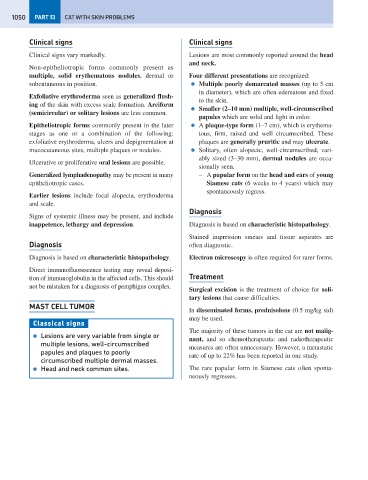Page 1058 - Problem-Based Feline Medicine
P. 1058
1050 PART 13 CAT WITH SKIN PROBLEMS
Clinical signs Clinical signs
Clinical signs vary markedly. Lesions are most commonly reported around the head
and neck.
Non-epitheliotropic forms commonly present as
multiple, solid erythematous nodules, dermal or Four different presentations are recognized:
subcutaneous in position. ● Multiple poorly demarcated masses (up to 5 cm
in diameter), which are often edematous and fixed
Exfoliative erythroderma seen as generalized flush-
to the skin.
ing of the skin with excess scale formation. Arciform
● Smaller (2–10 mm) multiple, well-circumscribed
(semicircular) or solitary lesions are less common.
papules which are solid and light in color.
Epitheliotropic forms commonly present in the later ● A plaque-type form (1–7 cm), which is erythema-
stages as one or a combination of the following: tous, firm, raised and well circumscribed. These
exfoliative erythroderma, ulcers and depigmentation at plaques are generally pruritic and may ulcerate.
mucocutaneous sites, multiple plaques or nodules. ● Solitary, often alopecic, well-circumscribed, vari-
ably sized (3–30 mm), dermal nodules are occa-
Ulcerative or proliferative oral lesions are possible.
sionally seen.
Generalized lymphadenopathy may be present in many –A papular form on the head and ears of young
epitheliotropic cases. Siamese cats (6 weeks to 4 years) which may
spontaneously regress.
Earlier lesions include focal alopecia, erythroderma
and scale.
Diagnosis
Signs of systemic illness may be present, and include
inappetence, lethargy and depression. Diagnosis is based on characteristic histopathology.
Stained impression smears and tissue aspirates are
Diagnosis often diagnostic.
Diagnosis is based on characteristic histopathology. Electron microscopy is often required for rarer forms.
Direct immunofluorescence testing may reveal deposi-
tion of immunoglobulin in the affected cells. This should Treatment
not be mistaken for a diagnosis of pemphigus complex.
Surgical excision is the treatment of choice for soli-
tary lesions that cause difficulties.
MAST CELL TUMOR
In disseminated forms, prednisolone (0.5 mg/kg sid)
may be used.
Classical signs
The majority of these tumors in the cat are not malig-
● Lesions are very variable from single or
nant, and so chemotherapeutic and radiotherapeutic
multiple lesions, well-circumscribed
measures are often unnecessary. However, a metastatic
papules and plaques to poorly
rate of up to 22% has been reported in one study.
circumscribed multiple dermal masses.
● Head and neck common sites. The rare papular form in Siamese cats often sponta-
neously regresses.

